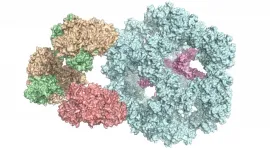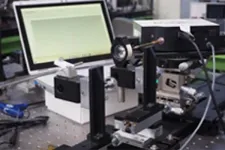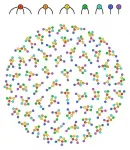What's the catch? Algal blooms influence fishing booms
2021-02-10
(Press-News.org) Satellite images reveal that the timing of algal blooms in the Red Sea may affect the next haul of sardines and squid by commercial fisheries.
Rising temperatures in the Red Sea have changed the timing of phytoplankton blooms. These microscopic algae form the base of many marine food webs and so are critical to ocean biodiversity and the industries that they support on land, such as fisheries and tourism.
A team led by KAUST climate modeler Ibrahim Hoteit has used satellite images to study the phenology of algal blooms in the northern Red Sea and their impact on fish catches. Phenology is the study of key stages in a species' lifecycle, such as when a seed sprouts or a bird migrates. Many phenological events are seasonal and can reveal a lot about the sensitivity of an ecosystem to environmental change. "We suspected that the timing of large phytoplankton blooms could impact fish further up the food chain, including those vital to fisheries," says Hoteit.
Using ocean color images taken weekly between 1997 and 2018, the team estimated chlorophyll-a concentrations -- a proxy for phytoplankton biomass. A model developed by lead author John Gittings was used to calculate the biomass of phytoplankton larger than two micrometers, such as diatoms, as these support food chains important to commercial fisheries. Gittings' model assumes that smaller phytoplankton do not grow beyond a specific chlorophyll-a concentration, so any extra chlorophyll-a in the system is due to large phytoplankton.
The data revealed that annual winter blooms lasted longer between 2002 and 2008 due to El Niño monsoon winds driving nutrient-rich waters into the Red Sea from the Indian Ocean. However, the 2002-2003 bloom lasted 11 weeks longer than average, suggesting some additional factor. Observations of sea surface height revealed two large eddies in the northern and central Red Sea at the start of this big bloom, which could have caused an upwelling of cold nutrient-rich waters.
The team then gathered fisheries catch data for several species of sardines and squid and found that prolonged algal blooms led to larger catches the following year. This was particularly evident in the bumper catch reported the year after the 2002-2003 bloom event. "We were surprised by the strength of the link," says Gittings. "It provides compelling evidence that anomalous changes in the timing of food availability may directly impact the success of species higher up the marine food chain."
Gittings plans to develop a model that can distinguish between different sized phytoplankton and use high-resolution images from next-generation satellite sensors to create a richer picture of phytoplankton communities in the Red Sea.
"Satellite-derived phytoplankton data could serve as an early warning system for fisheries by using changes in bloom timings to predict how next year's catch may be affected," suggests Gittings. Such data could help policymakers in Red Sea nations manage this essential ecosystem.
INFORMATION:
ELSE PRESS RELEASES FROM THIS DATE:
2021-02-10
A new method has enabled the natural structure of particularly large and complex enzymes to be revealed. Scientists at Martin Luther University Halle-Wittenberg (MLU) and TU Berlin have published their findings in the journal Cell Reports. They investigated a multi-enzyme complex that plays an essential role in metabolism and have discovered that it functions differently than previously thought. This will help scientists better understand certain diseases.
Enzymes are a cell's biocatalysts. They accelerate chemical reactions in the body or ensure that these reactions even take place at all. As a result, they play an extremely important role in metabolism. Individual enzymes frequently form a complex with many subunits, as in the case of the ...
2021-02-10
In a study conducted at the University of Helsinki, Finland, 136 adults adhered to one of three study diets for 12 weeks. One of them corresponded to the average Finnish diet, containing roughly 70% animal-derived protein of total protein, while most of the plant-based protein originated from cereal products. In the second study diet, half of the protein was derived from plant products and the other half from animal products, while the third one contained 30% animal protein and 70% plant-based protein of total protein.
Sources of animal protein, both red and white meat as well as dairy products, were partially replaced with plant-based proteins by adding a diverse range of legumes, nuts, ...
2021-02-10
Your breath holds the key to monitoring fat burning, and now a research group from Tohoku University has created a compact and low-cost device that can measure how our body metabolizes fat.
The device uses an ultraviolet lamp to gauge exhaled acetone gas, which is produced in the blood through the metabolic reaction of fat.
"Precise measurements of acetone gas concentration allows us to determine the body's ability to metabolize fat and develop exercise methods for efficient fat burning," says Professor Yuji Matsuura from Tohoku University's Graduate School of Biomedical ...
2021-02-10
Many natural and human-made networks, such as computer, biological or social networks have a connectivity structure that critically shapes their behavior. The academic field of network science is concerned with analyzing such real-world complex networks and understanding how their structure influences their function or behavior. Examples are the vascular network of our bodies, the network of neurons in our brain, or the network of how an epidemic is spreading through a society.
The need for reliable null models
The analysis of such networks often focuses on finding interesting properties and features. For example, does the structure of a particular contact network help diseases spread ...
2021-02-10
The research team led by Masakazu Ohara, graduate student of the Department of Computer Science and Engineering at Toyohashi University of Technology (student in the Leading Program doctoral program); Associate Professor Kowa Koida of the Electronics-Inspired Interdisciplinary Research Institute; and Associate Professor Juno Kim of the University of New South Wales (Australia) discovered that when people judge the thickness of an object, objects with glass-like transparent optical properties are perceived to be flatter than they actually are. It was previously known that objects made of metallic or glossy materials are perceived to be thicker than what they are, but now the current research has identified that transparent ...
2021-02-10
A description of gravity compatible with the principles of quantum mechanics has long been a widely pursued goal in physics. Existing theories of this 'quantum gravity' often involve mathematical corrections to Heisenberg's Uncertainty Principle (HUP), which quantifies the inherent limits in the accuracy of any quantum measurement. These corrections arise when gravitational interactions are considered, leading to a 'Generalized Uncertainty Principle' (GUP). Two specific GUP models are often used: the first modifies the HUP with a linear correction, while the second introduces a quadratic one. Through new research published in EPJ C, Serena Giardino and Vincenzo ...
2021-02-10
A unique 'heart-shape', with wisps of gas filaments showing an intricate honeycomb-like arrangement, has been discovered at the centre of the iconic supernova remnant, the Crab Nebula. Astronomers have mapped the void in unprecedented detail, creating a realistic three-dimensional reconstruction. The new work is published in Monthly Notices of the Royal Astronomical Society.
The Crab, formally known as Messier 1, exploded as a dramatic supernova in 1054 CE, and was observed over the subsequent months and years by ancient astronomers across the ...
2021-02-10
Dimerization (Note: combination of two identical or different molecules) of the human neuropeptides oxytocin and vasopressin can produce new types of bioactive molecules. In a recent study, an international research team led by MedUni Vienna and the University of Vienna demonstrated that dimerized and therefore significantly larger versions of oxytocin and vasopressin are still able to activate their receptors. Such new constructs provide several opportunities to optimize the efficacy of these neuropeptides for therapeutic application. The researchers were inspired for this approach from naturally occurring dimers. The results have been published in the journal "Chemical Science".
Oxytocin/vasopressin receptors are typical examples of so-called G protein-coupled receptors - the most ...
2021-02-10
In order for a drug to be effective at the right places in the body, it helps if scientists can predict as accurately as possible how the molecules of that drug will interact with human cells. In a joint research project, scientists from Collaborative Research Centre 1423 at Leipzig University and the Chinese Academy of Sciences in Shanghai have succeeded in elucidating such a structure, namely that of the neuropeptide Y receptor Y2 with one of its ligands. This is the first time that a molecular blueprint for this receptor is available, which will enable the development of tailor-made new drugs, for example to treat epilepsy or cardiovascular diseases. The researchers' findings have now been published in Nature Communications.
The Y2 receptor plays ...
2021-02-10
"Insulin is a prime example for a successful peptide drug that has been essential for the health of millions of diabetic patients in the past 100 years," says Markus Muttenthaler, who leads research groups at the Institute of Biological Chemistry of the Faculty of Chemistry at University in Vienna as well as at the Institute for Molecular Bioscience, at the University of Queensland in Brisbane.
Worldwide, peptide therapeutics account for 5% of the global pharmaceutical market, with global sales exceeding US$ 50 billion. More than 150 peptides are in clinical development and another 400-600 peptides undergoing preclinical ...
LAST 30 PRESS RELEASES:
[Press-News.org] What's the catch? Algal blooms influence fishing booms




